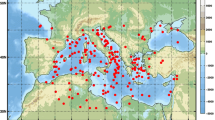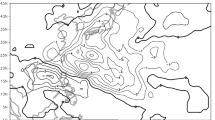Abstract
The winter extratropical cyclone activity in the Southern Hemisphere during the last one thousand years within a global climate simulation was analyzed by tracking cyclones, and then clustering them into ten clusters consecutively for each hundred years. There is very strong year-to-year variability for Southern Hemispheric winter extratropical cyclone numbers and larger variations on centennial time scale, more so than for its Northern Hemispherical counterparts. However, no obvious trend can be found. The mean tracks of clusters over the Southern Indian Ocean and near New Zealand shift poleward from the eleventh to the twentieth century while the clusters in the central Southern Pacific shift equatorward. Storm track clusters with largest deepening rates are found over the Southwestern Indian Ocean. In the twentieth century, rapidly deepening cyclones appear more often while long lifespan cyclones appear less frequently. The winter storm activity in the Southern Hemisphere is closely related to the Antarctic Oscillation. The cyclone frequency over the Indian Ocean and South Pacific Ocean can be associated with the Indian Ocean Dipole and El Nino-Southern Oscillation respectively.


















Similar content being viewed by others
References
Abram NJ, Mulvaney R, Vimeux F, Phipps SJ et al (2014) Evolution of the Southern Annular Mode during the past millennium. Nat Clim Change 4:564–569
Alexandersson H, Schmith T, Iden K, Tuomenvirta H (1998) Longterm variations of the storm climate over NW Europe. Global Atmos Ocean Syst 6:97–120
Ashok K, Nakamura H, Yamagata T (2007) Impacts of ENSO and Indian Ocean dipole events on the Southern Hemisphere storm-track activity during austral winter. J Clim 20(13):3147–3163
Bender FA-M, Ramanathan V, Tselioudis G (2012) Changes in extratropical storm track cloudiness 1983-2008: observation support for a poleward shift. Clim Dyn 38:2037–2053
Bengtsson L, Hodges KI, Roeckner E (2006) Storm tracks and climate change. J Clim 19:3518–3543
Bengtsson L, Hodges KI, Keenlyside N (2009) Will extra-tropical storms intensify in a warmer climate? J Clim 22:2276–2301
Blender R, Fraedrich K, Lunkeit F (1997) Identification of cyclone-track regimes in the North Atlantic. Q J R Meteorol Soc 123:727–741
Busuioc A, von Storch H (1996) Changes in the winter precipitation in Romania and its relation to the large-scale circulation. Tellus A 48:538–552
Chambers FM, Brain SA, Mauquoy D, McCarroll J, Daley T (2014) The ‘Little Ice Age’ in the Southern Hemisphere in the context of the last 3000 years: peat-based proxy-climate date from Tierra del Fuego. Holocene 24:1649–1656
Chang EKM, Guo Y, Xia X (2012) CMIP5 multimodel ensemble projection of storm track change under global warming. J Geophys Res. doi:10.1029/2012JD018578
Chen F, von Storch H, Zeng L, Du Y (2014) Polar low genesis over the North Pacific under different global warming scenarios. Clim Dyn 43(12):3449–3456
Chu P, Zhao X, Kim J (2010) Regional typhoon activity as revealed by track patterns and climate change. Hurricanes Clim Change 2:137–148
Dierckx P (1981) An algorithm for surface-fitting with spline functions. IMA J Numer Anal 1(3):267–283
Dierckx P (1984) Algorithms for smoothing data on the sphere with tensor product splines. Computing 32:319–342
Eichler TP, Gottschalck J (2013) A comparison of Southern Hemisphere cyclone track climatology and interannual variability in coarse-gridded reanalysis datasets. Adv Meteorol. doi:10.1155/2013/891260
Elsner JB (2003) Tracking hurricanes. Bull Am Meteorol Soc 84:353–356
Fischer-Bruns I, von Storch H, González-Rouco JF, Zorita E (2005) Modelling the variablility of midlatitude storm activity on decadal to century time scales. Clim Dyn 25(5):461–476
González-Rouco F, von Storch H, Zorita E (2003) Deep soil temperature as proxy for surface air-temperature in a coupled model simulation of the last thousand years. Geophys Res Lett 30(21):L2116
Goodwin ID, Browning S, Lorrey AM, Mayewski PA et al (2014) A reconstruction of extratropical Indo-Pacific sea-level pressure patterns during the Medieval Climate Anomaly. Clim Dyn 43:1197–1219
Gouirand I, Moron V, Zorita E (2007) Teleconnections between ENSO and North Atlantic in an ECHO-G simulation of the 1000–1990 period. Geophys Res Lett 34:L06705
Graff LS, Lacasce JH (2012) Changes in the extratropical storm tracks in response to changes in SST in an AGCM. J Clim 25:1854–1870
Grise KM, Son S-W, Correa GJP, Polvani LM (2014) The response of extratropical cyclones in the Southern Hemisphere to stratospheric ozone depletion in the 20th century. Atmos Sci Lett 15(1):29–36
Hodges KI (1994) A general method for tracking analysis and its application to meteorological data. Monthly Weather Rev 122:2573–2586
Hodges KI (1995) Feature tracking on the unit sphere. Monthly Weather Rev 123:3458–3465
Hodges KI (1999) Adaptive constraints for feature tracking. Monthly Weather Rev 127:1362–1373
Hoskins BJ, Hodges KI (2002) New perspectives on the Northern Hemisphere winter storm tracks. J Atmos Sci 59:1041–1061
Hoskins BJ, Hodges KI (2005) A new perspective on Southern Hemisphere storm tracks. J Clim 18(20):4108–4129
Jung T, Gulev SK, Rudeva I, Soloviov V (2006) Sensitivity of extratropical cyclone characteristic to horizontal resolution in ECMWF model. Q J R Meteorol Soc 132:1839–1857
Key JR, Chan AC (1999) Multidecadal global and regional trends in 1000 mb and 500 mb cyclone frequencies. Geophys Res Lett 26:2053–2056
Lim E, Simmonds I (2007) Southern Hemisphere winter extratropical cyclone characteristics and vertical organization observed with the ERA-40 data in 1979–2001. J Clim 20(11):2675–2690
Marsland SJ, Latif M, Legutke S (2003) Antarctic circumpolar modes in a coupled ocean–atmosphere model. Ocean Dyn 53(4):323–331
Matulla C, Schoener W, Alexandersson H, von Storch H, Wang XL (2008) European storminess: late nineteenth century to present. Clim Dyn 31:125–130
Meinardus W, Mecking L (1928) Das Beobachtungsmaterial der internationalen meteorologischen Kooperation und seine Verwertung nebst Erläuterungen zum meteorologischen Atlas. In: E.v. Drygalski (Hrsg.): Deutsche Südpolar-Expedition 1901–1903 im Auftrage des Reichsamtes des Innern. Verlag Georg Reimer, Berlin, Bd. III: Meteorologie Band I, 2. Hälfte, Heft, vol 1, pp 1–42
Mendes D, Souza EP, Marengo JA, Mendes MCD (2010) Climatology of extratropical cyclones over the South American-southern oceans sector. Theor Appl Climatol 100(3–4):239–250
Min S-K, Legutke S, Hense A, Kwon W-T (2005a) Internal variability in a 1000-yr control simulation with the coupled climate model ECHO-G. I: near-surface temperature, precipitation and mean sea level pressure. Tellus A 57:605–621
Min S-K, Legutke S, Hense A, Kwon W-T (2005b) Internal variability in a 1000-yr control simulation with the coupled climate model ECHO-G. II: El Niño Southern Oscillation and North Atlantic Oscillation. Tellus A 57:622–640
Murray RJ, Simmonds I (1991) A numerical scheme for tracking cyclone centres from digital data Part I: development and operation of the scheme. Aust Meteorol Mag 39:155–166
Nakamura J, Lall U, Kushnir Y, Camargo SJ (2009) Classifying North Atlantic tropical cyclone tracks by mass moments. J Clim 15:5481–5494
Neukom R, Gergis J, Karoly DJ, Wanner H et al (2014) Inter-hemispheric temperature variability over the past millennium. Nat Clim Change. doi:10.1038/NCLIMATE2174
Pezza AB, Simmonds I, Renwick JA (2007) Southern Hemisphere cyclones and anticyclones: recent trends and links with decadal variability in the Pacific Ocean. Int J Climatol 27:1403–1419
Pezza AB, Durrant T, Simmonds I, Smith I (2008) Southern Hemisphere synoptic behavior in extreme phases of SAM, ENSO, sea ice extent, and Southern Australia rainfall. J Clim 21(21):5566–5584
Raible CC, Blender R (2004) Northern Hemisphere Mid-latitude cyclone variability in different ocean representations. Clim Dyn 22:239–248
Rodgers KB, Friederichs P, Latif M (2004) Tropical Pacific decadal variability and its relation to decadal modulations of ENSO. J Clim 17:3761–3774
Roeckner E, Arpe K, Bengtsson L, Christoph M, Claussen M, Dümenil L, Esch M, Giorgetta M, Schlese U, Schulzweida U (1996) The atmopheric general circulation model ECHAM4: model description and simulation of present-day climate. Report No. 218, Max-Planck-Institut für Meteorologie, Bundesstr 55, Hamburg
Rosenthal Y, Linsley BK, Oppo DW (2013) Pacific Ocean heat content during the past 10,000 years. Science 342:617–621
Rudeva I, Gulev SK (2007) Climatology of cyclone size characteristic and their changes during the cyclone life cycle. Monthly Weather Rev 135:2568–2587
Serreze MC (1995) Climatological aspects of cyclone development and decay in the arctic. Atmosphere-Ocean 33(1):1–23
Sickmöller M, Blender R, Fraedrich K (2000) Observed winter cyclone tracks in the Northern Hemisphere in re-analysed ECMWF data. Q J R Meteorol Soc 126:591–620
Simmonds I, Keay K (2000a) Variability of Southern Hemisphere extratropical cyclone behavior, 1958–97. J Clim 13:550–561
Simmonds I, Keay K (2000b) Mean Southern Hemisphere extratropical cyclone behavior in the 40-year NCEP–NCAR reanalysis. J Clim 13:873–885
Simmonds I, Wu X (1993) Cyclone behavior response to changes in winter Southern Hemisphere sea-ice concentration. Q J R Meteorol Soc 119:1121–1148
Stendel M, Roeckner E (1998) Impacts of horizontal resolution on simulated climate statistics in ECHAM4. Report No. 253, MaxPlanck-Institut für Meteorologie, Bundesstr 55, Hamburg
Tan M, Shao X, Liu J, Cai B (2009) Comparative analysis between a proxy-based climate reconstruction and GCM-based simulation of temperature over the last millennium in China. J Quat Sci 24(5):547–551
Ulbrich U, Christoph M (1999) A shift of the NAO and increasing storm track activity over Europe due to anthropogenic greenhouse gas forcing. Clim Dyn 15:551–559
van Loon H, Taljaard JJ (1962) Cyclogenesis, cyclones and anticyclones in the Southern Hemisphere during the winter and spring of 1957. Notos 11:3–20
van Loon H, Taljaard JJ (1963) Cyclogenesis, cyclones and anticyclones in the Southern Hemisphere during summer 1957–1958. Notos 12:37–50
von Storch H, Zwiers FW (1999) Statistical analysis in climate research. Cambridge University Press, Cambridge
von Storch J-S, Kharin V, Cubasch U, Hegerl G, Schriever D, von Storch H, Zorita E (1997) A description of a 1260-year control integration with the coupled ECHAM1/LSG general circulation model. J Clim 10:1525–1543
von Storch H, Zorita E, Dimitriev Y, González-Rouco F, Tett S (2004) Reconstructing past climate from noisy data. Science 306:679–682
Vowinckel E, van Loon H (1957) Das Klima des Antarktischen Ozeans. Arch Meteor Geophys Bioklim B8:75–102
Wang XLL, Swail VR, Zwiers FW (2004) Climatology and changes of extra-tropical storm tracks and cyclone activities as derived from two global reanalyses and the Canadian CGCM2 projections of future climate. In: Preprints of the eighth international workshop on wave forecast and hindcast, 14–19 November 2004, North Shore, Hawaii
Wang XLL, Swail VR, Zwiers FW (2006) Climatology and changes of extratropical cyclone activity: comparison of ERA40 with NCEP–NCAR reanalysis for 1958–2001. J Clim 19:3145–3166
Wernli H, Schwierz C (2006) Surface cyclones in the ERA-40 dataset (1958–2001). Part I: novel identification method and global climatology. J Atmos Sci 63:2486–2507
Wolff JO, Maier-Reimer E, Legutke S (1997) The Hamburg Ocean primitive equation model. Technical Report, No. 13, German Climate Computer Center (DKRZ), Hamburg
Xia L, Zahn M, Hodges KI, Feser F, von Storch H (2012) A comparison of two identification and tracking methods for polar lows. Tellus A 64:17196
Xia L, von Storch H, Feser F (2013) Quasi-stationarity of centennial Northern Hemisphere midlatitude winter storm tracks. Clim Dyn 41:901–916
Yin JH (2005) A consistent poleward shift of the storm tracks in simulations of the 21st century climate. Geophys Res Lett. doi:10.1029/2005GL023684
Zahn M, von Storch H (2008a) Tracking polar lows in CLM. Meteorol Z 17(4):445–453
Zahn M, von Storch H (2008b) A long-term climatology of North Atlantic polar lows. Geophys Res Lett 35:L22702
Zolina O, Gulev SK (2002) Improving the accuracy of mapping cyclone numbers and frequencies. Monthly Weather Rev 130:748–759
Zorita E, González-Rouco JF, von Storch H, Montávez JP, Valero F (2005) Natural and anthoropogenic model of surface temperature variations in the last thousand years. Geophys Res Lett 32:L08707
Acknowledgments
We thank Eduardo Zorita for providing the ECHO-G simulation data, his support with statistic routines, and helpful discussions. We appreciate Kevin I. Hodges’ help with his tracking algorithm which was used for our study. We also acknowledge the German Climate Computer Center (DKRZ) Hamburg for the provision of high performance computing platforms. This study is sponsored by Yunnan Applied Basic Research Project (Foundation No. 2014FD003). The authors appreciate two anonymous reviewers for their constructive and helpful comments and suggestions.
Author information
Authors and Affiliations
Corresponding author
Rights and permissions
About this article
Cite this article
Xia, L., von Storch, H., Feser, F. et al. A study of quasi-millennial extratropical winter cyclone activity over the Southern Hemisphere. Clim Dyn 47, 2121–2138 (2016). https://doi.org/10.1007/s00382-015-2954-x
Received:
Accepted:
Published:
Issue Date:
DOI: https://doi.org/10.1007/s00382-015-2954-x




